Automation Trends
Automation in the time of COVID-19: An A&E/C perspective
COVID-19 has demonstrated even more greatly the benefits of automation—from process to packaging to the distribution center
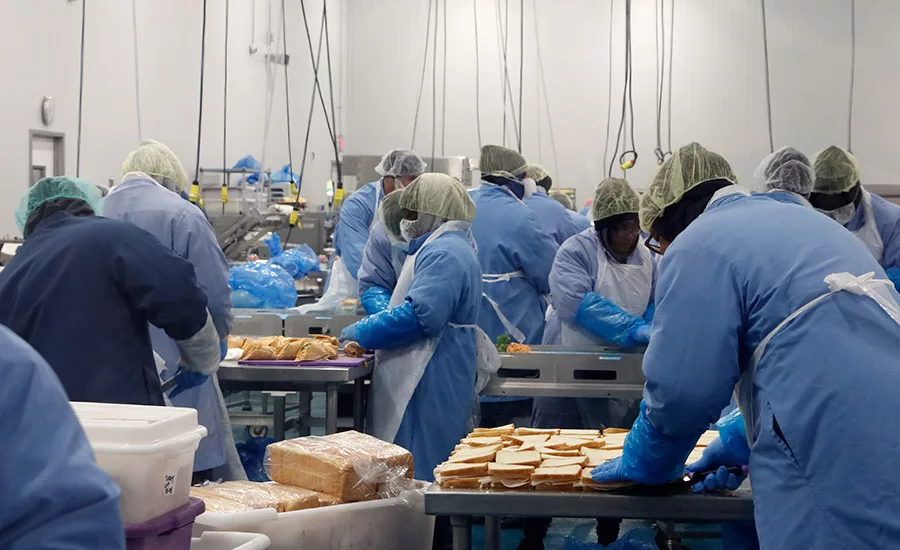
Pre-COVID-19 hand assembly line has workers close together. Under COVID-19 rules, social distancing would require each station to be at least six feet from its neighbor. All photos courtesy of Wayne Labs
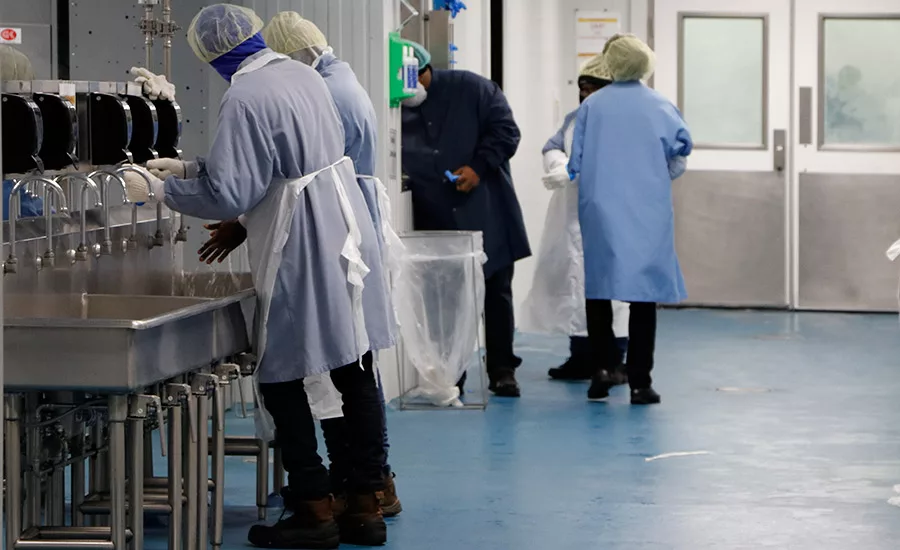
Washroom pre-COVID-19 has wash basins next to each other. Would this room and equipment need to be redesigned to meet CDC rules?

Today’s automated facilities with Wi-Fi connections let operators look at production schedules and KPIs on their smartphones or tablets.
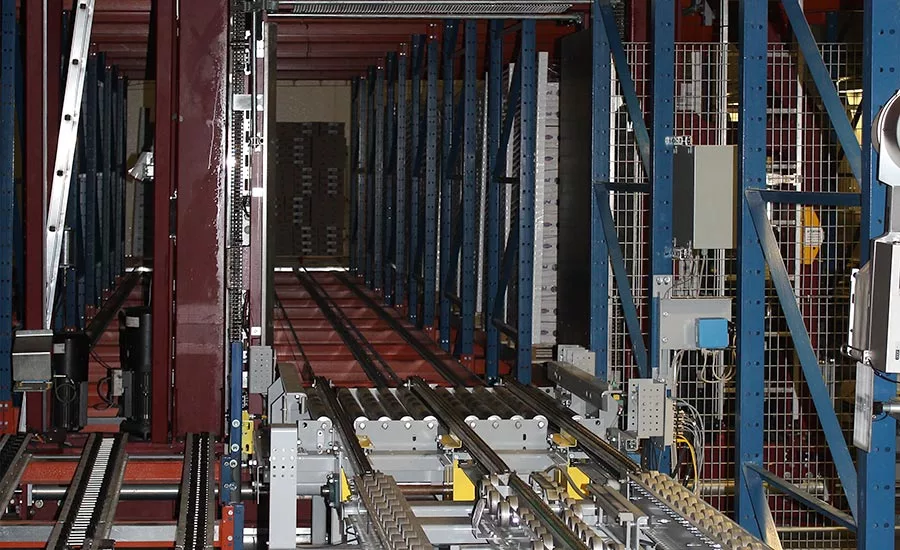
Entrance to AS/RS from AGV tracks. Today’s AS/RS is completely automated and waits for pallet loading robots to finish a pallet before the AGV transports the loaded pallet to the warehouse.
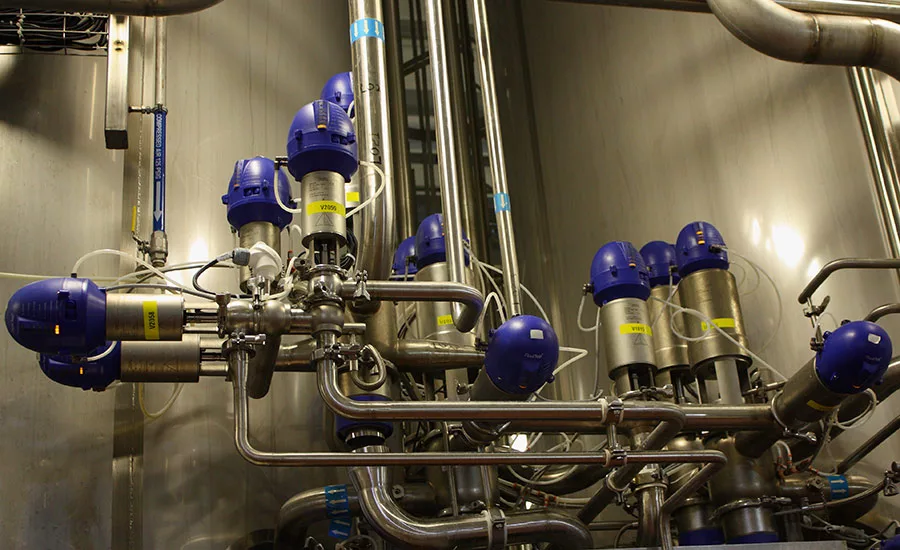
Instrumentation and remote controlled mixproof valves coupled to the automation system schedule flow of ingredients and wash solutions.
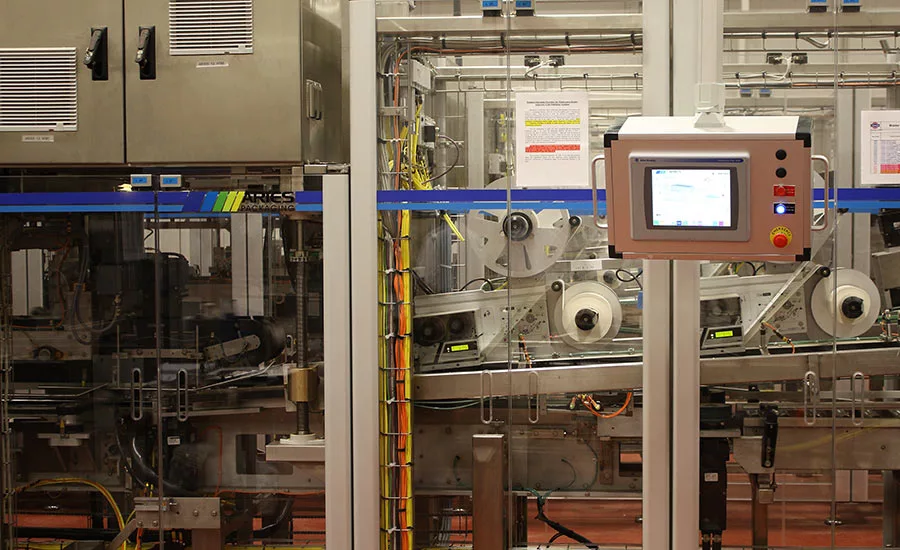
While work cells, such as this primary packaging cell, have their own local controls, today’s automation systems combine all the data from all the cells and can run the plant as a “lights-out” factory.
We in the trade press have been extolling the virtues of automation for a long time, and you’re probably sick of hearing us ramble on about it. Nevertheless, if there were any other reason to take a hard look at implementing automation—at least partially—in your facility, it would be now. COVID-19 has certainly created some practical problems: Short-staff due to people at home sick with coronavirus, social distancing impossible on cutting/protein lines, changeover time killing production output…and the list goes on.
You’re probably also sick and tired of hearing the usual automation vendors tell you how you could have been up and running if you only had their automation system. Problem is, one vendor’s automation system isn’t likely to provide all the solutions you need—and then you face the challenge of having several vendors’ automation systems “talking” (or not) to each other and speaking the same language and dialect.
So, this article takes a look at automation from a non-automation-vendor point of view—from architects and engineers who deal with not only designing and building plants, but also configuring and installing automation systems from several suppliers, and making them work together. In the 44th Annual Plant Construction Survey this year, I asked architectural and engineering/construction (A&E/C) firms for their observations on trends in automation. Who better to provide a neutral viewpoint on automation—from building controls to process and packaging controls to warehouse automation—whether plant-wide or more focused on a problem process or packaging line? The benefit of choosing an A&E/C firm or an engineering house is that they’ve seen it all and can provide you with honest answers to your automation questions.
A&E/Cs are typically automation brand agnostic—that is, they help you choose whatever equipment gets the job done. Being brand agnostic is one piece of advice I received as a young engineer many moons ago, and it still applies today. As Ron Stewart, Jr., P.E., program manager | National Food Group, Shambaugh & Son says, “[Food] companies are beginning to realize how handcuffed and expensive it can get locking in with one automation company.”
COVID-19: Should we automate…and where?
If you see your competitors turning to automation, you wouldn’t be alone. As Ronald Rens, P.E. and president of Gleeson Constructors & Engineers put it, “We see an increase in automation in processing, packaging and warehousing/logistics due to hiring challenges and retaining team members.” There’s also an increase in storage, shipping and packaging automation. The only downside to automation as Rens sees it is that these projects take longer to build as there is so much more to consider in the design phase, and parts/equipment procurement adds to delays in completing a facility.
Depending on the product(s) you make, adequate and filtered air changes are already important to meet FSMA requirements, but because of COVID-19, the CDC has recommended further air changes to make buildings safer, says Dan Crist, AM King VP. But beyond this issue, Crist says that his food and beverage clients are struggling with lack of available labor and are becoming more interested in automation and robotics as a means of moving more product through a plant with fewer people on staff.
With cost-conscious clients, automation is generally applied to the extent required to meet their production needs, says Chris Vigil, Black & Veatch project manager. In many cases, manual labor may be sufficient for the operational task. Automation is being used where there is a labor-driven bottleneck or where quality expectations are required to be at a consistent high level, with little room for error. Automation comes at a cost and while attractive, it is commonly pulled back some when budgetary costs are exposed.
“In the past we’ve seen automation generally implemented from a cost/labor saving standpoint,” says David Ziskind, Black & Veatch director of engineering. Now, there is interest in using automation for safety (i.e. to remove personnel from dangerous tasks), as well as to supplement labor where there are shortages in the local market. In some regions, the availability and cost of labor does not lend itself well to automation; yet in others, automation is practically required due to lack of available labor.
The pandemic moved the point of sale of many products, specifically food production, shifting from commercial to consumer and creating production bottlenecks for many companies, says Mike Chambers, project manager, Burns & McDonnell Food & Consumer Products Group. It also created demand for certain products. Overall, this altered the investment of capital from strictly an ROI exercise to maintaining business continuity. Thus, the combination of evolving demands, production bottlenecks and social distancing significantly increased the need for automating manual tasks, especially those requiring close contact. Not only did the industry experience strain in the production facilities but also the supply chain as it, too, changed course to meet shifting demands.
Cost justifications—labor the big issue
Acceptance of automation to solve labor-specific problems has increased. “There seems to be much more willingness to invest in automation these days in all areas of a manufacturing facility that makes sense,” says Ed Wright, The Austin Company project executive. The ROI hurdles have been somewhat relaxed to enable the use of more automated processes.
“We’re seeing much more automation, and we’re seeing companies take more risk on return on investment for labor savings,” says Steve Tippmann, executive VP at the Tippmann Group. Labor costs are going up faster than costs can be passed through to the customer—and labor availability is even harder, which makes labor more expensive, so other alternatives to handle the product need to be figured out, and automation is a way to do that.
Labor shortages continue to push the introduction of automation and robotics, says Darrin McCormies, Epstein senior vice president, director of industrial services. Clients are willing to consider labor saving projects at a less favorable ROI just to reduce staffing because staff is so hard to find. However, McCormies says that processors still need to be convinced that robotics can be effectively used in some challenging processing and packaging lines.
Food companies will continue to embrace a greater degree of automation due to labor shortages and the fact that COVID-19 will have lasting implications on employee density on a production line, says Mary Francess Stotler, Dennis Group senior partner. This is probably most evident among protein processors, who were subject to high profile issues early in the pandemic. Initially, crowded lines proliferated the spread of COVID among employees. Currently, some cutting lines are still running at only 50% throughput—only every-other-shackle can be utilized. Companies are investing in more long-term, permanent design changes to automated lines that will improve efficiencies while addressing the need for continued spacing of employees and flexibility with products.
Robotics costs are coming down and making projects more viable to reduce manpower costs and produce a more consistent product, says Lloyd Snyder, senior VP at Woodard & Currann. Labor shortages are also driving automation in general as manufacturing becomes more complex and requires strict quality standards.
Automation technology fills many roles and encourages workforce
Food processing plants, warehousing and distribution facilities are becoming more automated since the available workforce is getting more competitive as workers are harder to find, says Timothy Nguyen, ESI Group USA senior VP. “We are seeing more processing facilities incorporating many pieces of equipment to provide advantages with food safety being at the forefront.”
X-ray equipment, automatic leak detection for packaging lines, sanitizers, auto-sealers, sorters, overhead power rail systems, automated carcass splitters, hydraulic indexers, automated shrink wrappers, steam tunnels, box erector systems, palletizers, and pallet wrappers, not only contribute to overall output of product safely, but also the health of the employees who work on these lines by reducing repetitive tasks and exposure to harsh environments in these facilities, says Nguyen.
What used to be cutting edge has now become routine in many projects, says Keith Perkey, VP—Food and Beverage Division, The Haskell Company. “With better connectivity, smaller sensors, and the internet of things (IoT), we are seeing much more data coming from the field or on-the-floor systems. We are seeing more data from machines regarding maintenance cycles and an increased use of camera systems for security and production monitoring. The control networks in both processing and packaging systems are becoming faster, more reliable and simpler to install. The automation in the packaging and processing systems often allows for more flexibility to handle a larger variety of products with faster changeovers.”
Sometimes not considered is that automation can actually help draw in and retain a workforce, adds Nguyen. Management teams have seen an overall attendance increase when an effort is made to invest in equipment that helps employees with the daily work at hand—by allowing employees more control over the line performance individually that in turn, can help the team increase output and performance bonus potential.
Robots take on more tasks, but face some challenges
Robotics are now commonplace in most food companies, as costs have dropped, technology has improved, and maintenance departments are more comfortable with the technology, says David Watson, engineering SME, food, baking & snacks, The Austin Company. However, automation can have limitations. As robotic systems require good quality product to reach the robotic cell, often times scrap rates increase, as what was once able to be packed manually cannot be packed with robots. This just places a higher emphasis on the front end of the process, adds Watson.
With robotics and other large-scale automation, personnel safety can be an issue. “The amount of caging needed, safety interlocks, etc. can increase the cost of automation and reduce the flexibility in producing a variety of products,” says Emily Napolitan, Food Plant Engineering process engineer. In addition, if a process is highly automated and there is a problem along the line, the whole line may have to be shut down. This can affect productivity, though it’s important to weigh productivity gains with occasional downtime.
There may be a partial solution to some robotics applications that have traditionally been fenced off. “An increasing demand for collaborative robots (cobots) in secondary packaging areas has been accelerated by the pandemic,” says Napolitan. Most robotics have not been designed to operate to food safety standards, but easily programmable and flexible robotics have been incorporated into facilities for case packing and palletizing. Cobots are also easily re-programmable to fit the needs of production and can accommodate different packaging designs.
“We are seeing more robots, including collaborative robots (aka cobots) in plants, and this trend will most likely grow in the coming year,” says Craig Cheevers, Hixson manager, automation. “While today’s cobots cannot keep pace with most line speeds, this is rapidly changing. We expect that they will soon be able to evolve to faster line rates.”
Industry 4.0 and data more important than ever
“One of the ongoing trends in automation is Industry 4.0, and the convergence between Information Technology (IT) and Operational Technology (OT) is growing, says Cheevers. Essentially, OT components such as plant- and floor-level communications are more often becoming integrated with data dashboards and other IT-level controls and equipment.
IIoT and Industry 4.0 have opened up many opportunities to reduce downtime, leverage preventative maintenance opportunities, and monitor energy usage, says Watson. With minimal investment, food processors can now get instant information on a production line through their smartphone or tablet. Sensor technologies tied to MES systems at a facility can determine when a critical production line component is about to fail, allowing for the component to be replaced during a scheduled downtime event.
As industries quickly pivoted because of the pandemic, automation trends emerged, including obsolescent upgrades (such as certain equipment, process and Windows-based operating system upgrades), says Alfredo Valadez, project manager, Burns & McDonnell Manufacturing Group. Businesses began to implement thin client technology—allowing operators to access sensitive project information simply and safely by remotely connecting to a server-based computing environment—as well as realizing the benefits of the virtualization of distributed human-machine interface applications. Safety programmable logic controllers, safety input/output (I/O) and hot swappable distributed I/Os became a priority. The challenge of how to seamlessly integrate new technology and execute projects, however, still exists, mainly as they relate to safety lockout/tagout, duration of projects and anticipated downtime.
Distributed in nature, but centralized in the sense that data from all machines and equipment is available in one overall system to any person anywhere is key to operations today. To the point, there is a trend away from machine-level HMIs to central user management systems, says Dennis Group’s Stotler. Distributed applications can include visualization, historical data and trending, alarm and event monitoring, downtime and manufacturing KPI tracking, as well as asset management, change management, and access controls. All adjustments, recipes, and parameters can be managed from thin client workstations so recipe management is integrated across a facility seamlessly.
Data access no longer a nice-to-have
Data communications is at the heart of all the things just described above, and without it, automation would be back at the “islands of automation” stage in history.
“Data access has become a requirement instead of an option,” says Tyler Cundiff, president, Gray, Inc., Food & Beverage Market. Access to data across building, utility, and process systems is now viewed as a common practice for new or retrofit installations as well as gathering and reporting on a common platform. Increased access to data and reporting continues to support modernization or cost-saving projects with expectations for reduced yield loss and increased quality control.
Reliable, resilient Wi-Fi enabled network infrastructure, which puts real-time data at the fingertips of employees on the plant floor, can assist with visualization, alarm and event monitoring, downtime, and manufacturing/KPI tracking, as well as asset management, change management, and access control data, says Stotler.
“The discussion of automation and digital integration has now become a major topic with every one of our food & beverage customers, and as a result, we have invested for our customers and grown our in-house capabilities to include over 150 engineers who are experts in the digital and automation field of work,” says Cundiff.
The final frontier: Warehouse automation and AI/ML
Labor-related quality, availability, and legislation have pushed automated material handling for both raw materials and finished goods to become a common request on all projects—nearly every new project includes a form of this in its scope and in-house expertise is a must have, says Cundiff.
Looking to employ a smart investment strategy as well as keep operations running, facilities have also turned to warehouse automation, propelled by a surge in online shopping, Chambers adds. Though e-grocery automation had already been slowly increasing, it grew at an abnormally faster pace during the pandemic.
Within this new world of business, industries started to witness real-world case studies of AI and machine learning in material handling and warehouse automation projects, says Chembers. For example, a large parcel company now is using AI to help sort small parcels that were not able to be sorted automatically due to size and shape complexity. The system will continue to learn and improve uptime—and the more it runs, the more it learns and gets better at its task. AI helped the company reduce the physically demanding task from operators, and it is expected that there will be more of these applications this year as well as various solutions that address other difficult-to-automate tasks.
Automated warehousing is one of the only remaining areas that can significantly reduce long-term costs, says Mark Livesay, VP Automated Warehousing for ESI Group USA. An AS/RS has a life expectancy of 25+ years and has a typical payback of 3-5 years depending on the system complexity.
Long-term thinking when investing in an AS/RS is prudent, as additional savings can be seen through reduced labor, damaged product, and maintenance costs, all the while increasing accuracy and productivity within the warehouse, says Livesay. “An AS/RS can be sized for heights up to 150 feet or as low as 20 feet—whether you are looking to retrofit an existing building or build a tall rack supported building to fit your current property,” says Livesay.
Livesay describes components of warehouse automation as follows. Types of order picking systems:
Layer picking: Where a pallet is automatically brought down and conveyed into a layer picking area where a gantry robot will pick a layer off the pallet and build a mixed pallet with different layers of product.
Case picking: Individual cases are stored in a mini load AS/RS or multi-shuttle where individual cases are picked and conveyed to a palletizer to get palletized.
The closer you get to individual piece picking the automation costs go up exponentially, says Livesay. AGVS (automatically guided vehicle systems) are being more accepted and used more frequently in warehouses and distribution centers.
There are basically two types of AGVs. The forklift type can store and retrieve product on multiple levels, and pallet movers are used where the product is either conveyed onto or off the AGV or the pallet is placed onto a cart where the pallet is towed to the desired location.
Get help from the experts
There are always tradeoffs when considering to what level to automate a facility, but the critical factor is to have the experts at the table very early in the process and to consider carefully all options. This includes key representatives from the processor’s company, system integrators, engineers and architects.
Finally, if you already work with an A&E/C firm, you know the advantages. Today, most A&E/C firms can handle automation projects, and if they don’t have the expertise in house, most likely they’ve partnered with an engineering house or system integrator in your area.
►Don't forget to visit our 44th Annual Plant Construction Survey!
A word of thanks to those who helped with this article
The following is a list of not only A&E/Cs who participated in this article, but a list of those who participated in this year’s Plant Construction Survey. I’m grateful to them all for helping out with this gigantic annual project.
|
A M King |
www.amkinggroup.com |
|
Alberici Constructors |
https://alberici.com |
|
ARCO National Construction |
www.arconational.com |
|
Black & Veatch NextGen Ag |
www.bv.com |
|
Burns & McDonnell |
www.burnsmcd.com |
|
Clayco |
https://claycorp.com/ |
|
CMC Design-Build |
www.cmcdesign-build.com |
|
CRB |
www.crbusa.com |
|
Dennis Group |
www.dennisgroup.com |
|
E.A. Bonelli + Associates |
www.eabonelli.com |
|
Epstein |
www.epsteinglobal.com |
|
ESI Group USA |
www.esigroupusa.com |
|
Faithful+Gould |
www.fgould.com |
|
Food Plant Engineering |
www.foodplantengineering.com |
|
GALBRAITH Pre-Design, Inc. |
www.gp-inc.com |
|
Gleeson Constructors & Engineers |
www.gleesonllc.com |
|
Gray |
www.gray.com |
|
Hixson |
www.hixson-inc.com |
|
Mead & Hunt |
www.meadhunt.com |
|
Shambaugh & Son |
www.shambaugh.com |
|
Spec Engineering |
https://www.gray.com/spec/ |
|
SSOE Group |
www.ssoe.com |
|
Stellar |
www.stellar.net |
|
The Austin Company |
www.theaustin.com |
|
The Haskell Company |
www.haskell.com |
|
Tippmann Group |
www.tippmanngroup.com |
|
Woodard & Curran |
www.woodardcurran.com |
Looking for a reprint of this article?
From high-res PDFs to custom plaques, order your copy today!







